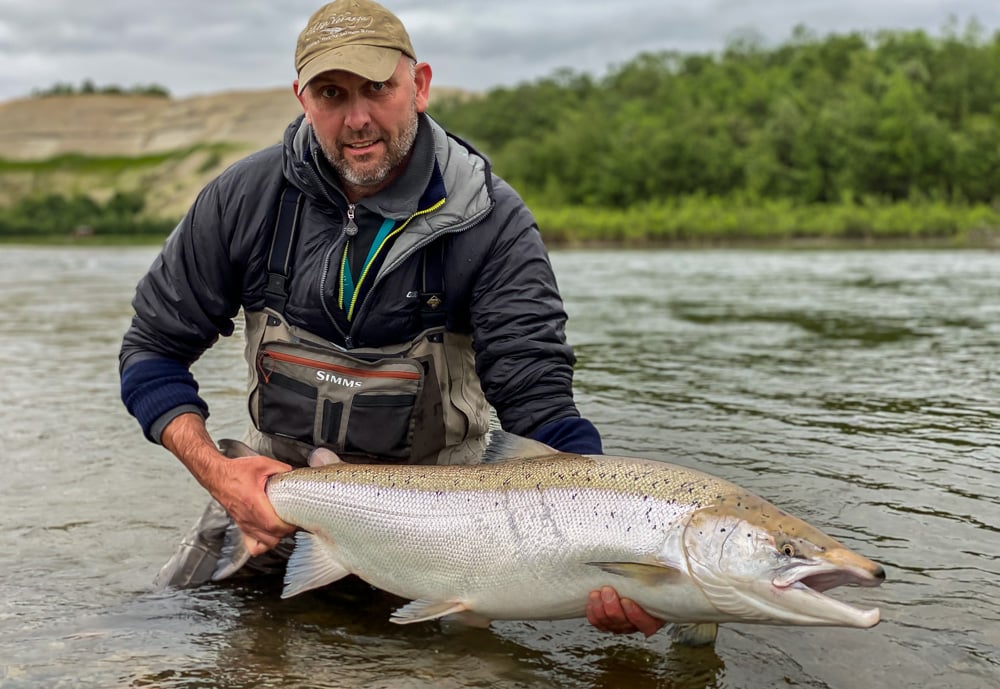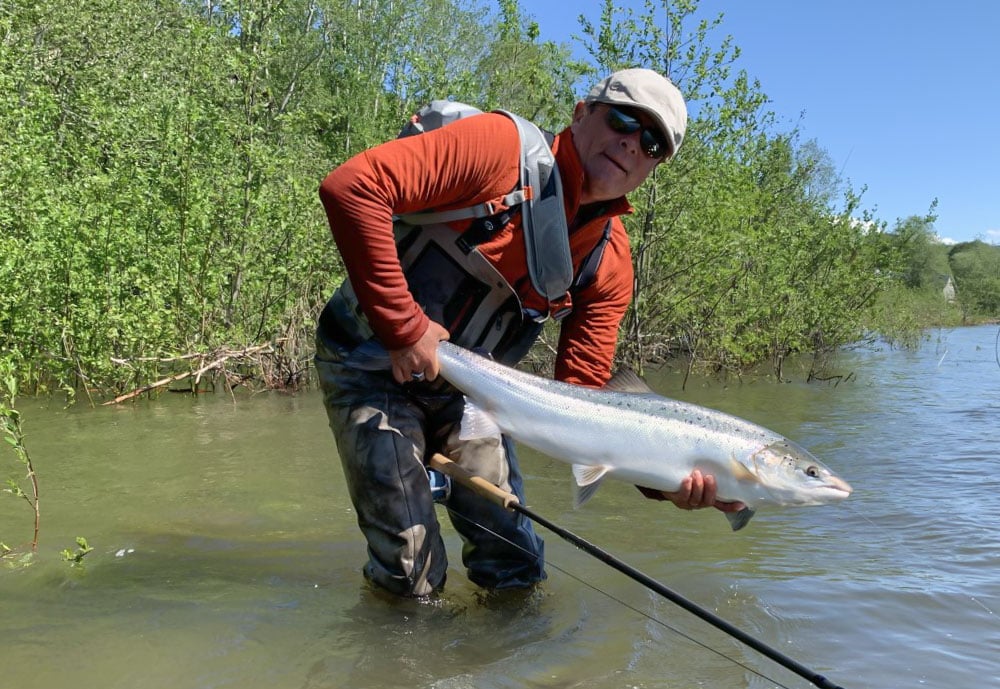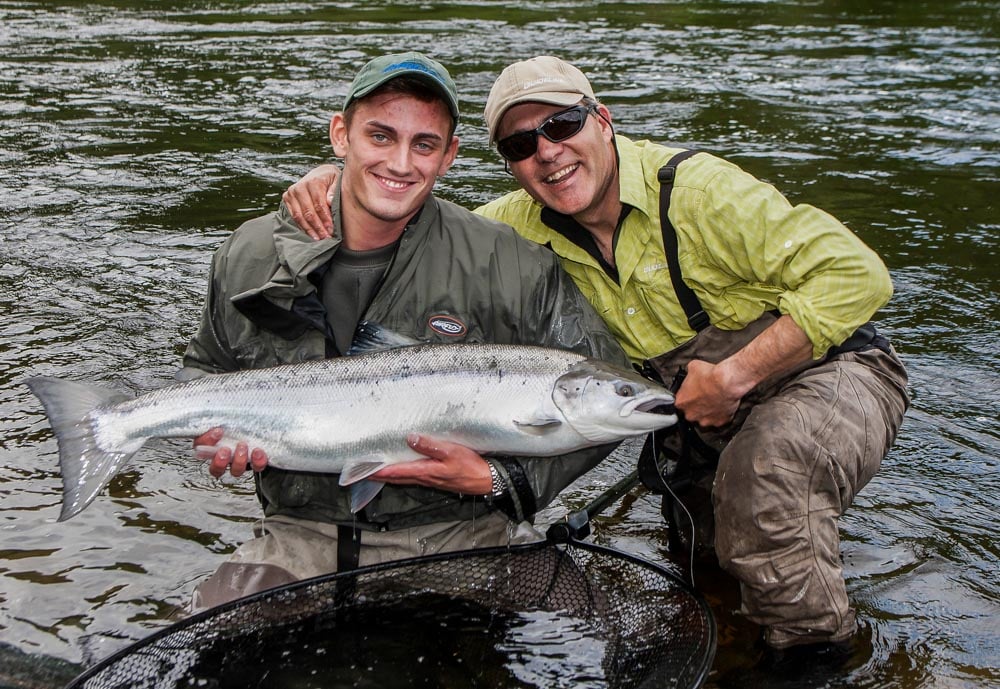

Norway is a country situated in northern Europe, with wonderfully diverse, beautiful natural landscapes. It’s known for being one of Europes happiest countries and is famous for its fjords and northern lights. It’s also known as the ‘land of the midnight sun’, as remarkably the sun doesn’t set in the summer months, giving almost 24 hours of daylight.
Much of the country is dominated by mountainous or high terrain, with various natural features caused by prehistoric glaciers and varied topography. These sights are extremely popular with tourists, and it’s no surprise that Norway was recently voted the ‘world’s most unspoilt travel destination’. However, it’s not just sight-seeing tourists who visit in great numbers, as Norway is extremely popular amongst travelling anglers, who venture in their thousands to take advantage of the unbelievable freshwater fly fishing the country has to offer.
The Atlantic Salmon fishing in Norway is home to some of the world’s most giant specimens and is a true bucket-list destination for the fly angler, with countless lakes and rivers to cast a fly in too. The Orkla, Gaula, Lakselva, Reisa, Namsen and Alta rivers are some of the most popular, both for the numbers of fish and size, with fish to over 30lb landed every season.
Below we have listed the main destinations for you to choose from.


Namsentunet Lodge, one of Norway’s most exclusive Atlantic Salmon and Sea Trout fishing retreats, is nestled on the banks of the famous river Namsen, affectionately known as the ‘Queen of Rivers’. The Namsen is famed for its huge Salmon, and each year, good numbers of 40-45lb fish get landed by travelling rods.


The Stangnes Lodge on the Lakselv River was, built in the summer of 2019, is a self-catering Lodge designed for single fishermen or small groups looking for an independent fishing schedule. It offers travelling freshwater fly fishing anglers five private, single bank beats of varying lengths and some world-class Atlantic Salmon fishing.


Olderø Lodge on the Lakselv is an authentic piece of fly fishing paradise in the land of the midnight sun. With a vast array of different beats, easy wading, two-handed fly fishing, world-class guides and first-class accommodation, it's no surprise that the destination is now at the very top of many freshwater fly fishing anglers wishlists.


Austnes Salmon Lodge on the Verdalselva River offers travelling freshwater fly fishing anglers the chance to sample some of the best Atlantic Salmon fishing found anywhere in Norway. The Lodge provides visiting rods with a varied week of fishing with five different zones, four of which are exclusive, spread over 2000m of prime Salmon holding habitat.


Reisastua Lodge on the Reisa River has a reputation for big Salmon that are caught annually here weighing around 20 kg. So if you are looking to set a record, the Reisa River may be the right place for you, just ask Scott Mackenzie who has caught his last 3 personal best Atlantic Salmon with us.


Winsnes Lodge on the River Gaula is a great destination for any Salmon angler wishing to experience a well run Salmon river. The Gaula River appears in the top five rivers in Norway most years for its regular catch statistic’s and Winsnes Lodge is a very large contributor to these statistics.


Average Customer Satisfaction Score 89%


The Orkla River is 180 kilometres in length and the fourth largest in Norway by volume, and the largest in Trøndelag county. The river follows the Orkdalen valley, discharging into the Orkdal Fjord, an arm of the large Trondheimsfjorden, at Orkanger. The river is regulated by five power generation reservoirs, used as a successful flood control method preventing the river’s major seasonal flooding.
The Orkla is very popular for Atlantic Salmon fishing, and an 88-kilometre long stretch of the river through Orkdal, Meldal, and Rennebu is used throughout the season. The Salmon fishing season typically runs from 1st of June through 31st of August. The river is approximately 50 and 70 yards wide so even though the wading is moderate, covering the water for the average angler is obtainable.
The Salmon in the river are typical Norwegian fish, with deep chrome bodies and big powerful tails, perfectly designed to travel at speed through mighty rivers and long distances. They can grow to impressive sizes, too, with 30lb+ fish landed every year.
The Gaula river is 153 kilometres long and the largest in central Norway. It begins in Holtålen municipality near the mountain Kjølifjellet. It then flows through the cities of Holtålen, Midtre Gauldal, and Melhus before emptying into Trondheimsfjord. On its way, it’s joined by one large tributary, the Sokna, as well as several smaller tributaries, including the Rugla, Hesja, Holda, Forda, and Bua.
Within the Gaula River, there are two well-known waterfalls called Gaulfoss, close to the village of Hovin and the Eggafoss near the town of Haltdalen. It’s an entirely free-flowing river, with no dams along its path, so as a result, its levels get dictated by rainfall and snowmelt; this provides varying conditions throughout the season, both challenging moments and others of great opportunity.
The Gaula was named the best Salmon fishing river in Norway in 2005 and is consistently named in Norway’s top 5 Salmon rivers. Its yearly catch stats still put it in contention to regain its crown each year. It offers excellent possibilities for fish of over 20lbs with occasional fish that may even surpass the 40lb mark.
The Lakselva is a river in Troms og Finnmark county in northern Norway; it flows for 103 kilometres and starts its journey in Karasjok, running north through Porsanger Municipality into the Porsangerfjorden, a fjord off of the Barents Sea.
This clear running river is divided into four beats, each of which has a fixed number of public rod licences each day. These are monitored to ensure the river doesn’t receive too much angling pressure.
Whilst other rivers in Norway may produce more Salmon, the Lakselva is ideal for those seeking that monster. In recent years the average weight of the Salmon caught has been over 12lb, but many fish over 40lb have been landed, and the biggest fish reported to date is a giant of over 65lb.
From August, the river is excellent for Sea Trout Fishing, and there’s also great opportunities for Trout and Grayling fishing further up the river.
The Reisa is a river in Nordreisa municipality in Troms and Finnmark county. It flows from Lake Ráisjávri for 120 kilometres in a northwesterly direction through Reisadalen to the mouth of the Reisafjord at the municipal centre Storslett. Its name comes from the Old Norse verb Risa, meaning “rise”.
Out of the 120 kilometres the Reisa flows for, only 85 kilometres are fishable. The returning Atlantic Salmon can only swim that far before they reach the unsurpassable obstacle of the Imofossen Falls. Like its sister river a bit farther north, the Alta, the Reisa can claim that at least 40% of returning Salmon weigh over 15lbs and more than half of these weigh in at over 20lbs. In contrast to the evolution of many salmon rivers worldwide, the return of large Salmon to the Reisa is improving from year to year, and now few rivers in the world can boast such high probabilities of hooking fish in the 30lb+ range.
There’s no doubting that the Reisaelva is one of the country’s best salmon rivers, but it’s also famous for canoe and riverboat trips.
If you visiting Norway fishing for Atlantic Salmon, then why not read our blog on Atlantic Salmon Fishing Tips.
The Altaelva, or Alta as it’s known in English, is the third-longest river in Troms og Finnmark county, flowing for 240 kilometres. The river begins in the mountains and lakes in Kautokeino Municipality, just south of Reisa National Park, running northward into Alta Municipality, where it flows out into the Altafjorden in the town of Alta. On its journey towards the sea, the mighty river carved out Sautso, one of the largest canyons in Europe.
The Alta is one of the best Salmon rivers in Norway, known for its large-sized Atlantic Salmon. In years gone by, fish up to 73lb have been recorded, and fish up to 53lb still get caught today. In 2011 over 1,000 Salmon of 15lb or heavier were landed on the river.
The river and its surroundings comprise great natural beauty, with opportunities for campfires and barbeques along the riverbank.
The Namsen is one of the longest rivers in Trøndelag county, in the central part of Norway, flowing for 228 kilometres. The river begins in Børgefjell National Park before flowing through the municipalities of Røyrvik, Namsskogan, Grong, Overhalla, and Namsos, emptying into the Namsenfjorden. The river is the namesake of the whole Namdalen region.
The Namsen is considered one of the best Atlantic Salmon fishing rivers globally and is often named the “Queen of Rivers”. The fishing was discovered early in the 19th century. Since then, it’s been a significant attraction for travelling freshwater fly fishing anglers, who visit to try and catch that fish of a lifetime; Atlantic Salmon to over 50lb are not unusual.
The Namsen is a wide river and is thus often fished from small boats using a method called “harling”. This method consists of trolling a lure while the boat moves slowly from bank to bank and drifting downstream. Thus, the Salmon meets the lure as they swim upstream.











